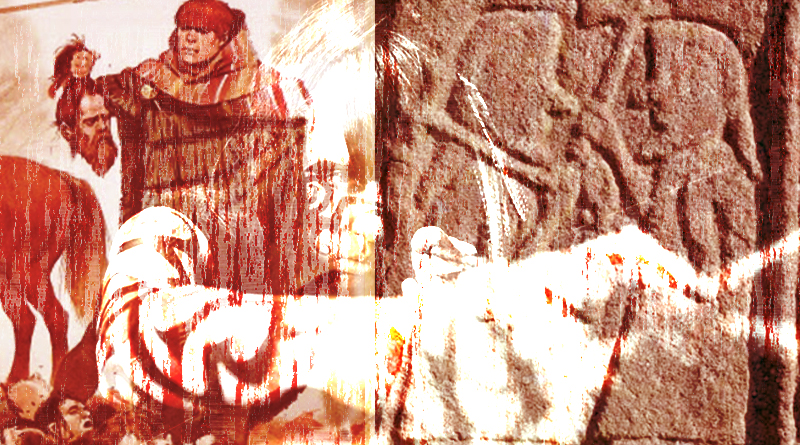Long before the city of Dundee arose, the land around the Tay estuary was the site of many a battle and skirmish. There is evidence showing the Law being used as a fort back to the Iron Age, and remains from Roman times can also be found…but evidence of any long-ago fought battles is lost to us.
The earliest referenced battle fought on these lands was the “Great Battle” where Alpin lost his head to the Picts in 836. The Battle of Pitalpin was fought in the Liff area, to the west of what was the village of Pitalpin; a small village named because it was the resting place or ‘pit’ of Alpin.
This story of King Alpin battling the Picts is something of a legend in Dundee’s history, with conflicting accounts on the exact date, and even the location of the battle. Many records and important details of Scottish history were lost in the many wars of independence as well as invasions, particularly from Edward I, as though seeking to quash any ideas of an independent Scotland by erasing its history.
We’ll choose to go with the account taken from ‘The History of Dundee’ by James Thompson, published in 1847 and available here (http://archive.org/stream/historyofdundeeb00thomuoft/historyofdundeeb00thomuoft_djvu.txt) in full text.
In 836, Scotland was not the united nation we know today, and was divided roughly into the Scots, who were Gaelic people on the west, the Picts who claimed the land from the firth of Forth northwards, the Scots of Dál Riata (the west coast), the Britons of Alt Clut (Strathclyde) and the Anglian kingdom of Bernicia (southern Scotland and Northern England).
Alpin was King of the Scots, but was also the grandson to Hungus, King of Pictland, and thus he laid claim to their kingdom. The Picts themselves chose another King, Brude, after King Alpin had invaded their land, laying waste and exercising great cruelty to the Pictish people, ‘spairing sex nor age’ in his bloodshed while invading the Lothian region.
Brude gathered a great army, and crossed the river Tay at the castle of Caledonia (Dunkeld) marching towards Angus to meet Alpin in battle. He met Alpin who had a force of 20,000 scots in the fields where Liff and Camperdown now sit. Initially Alpin witnessed the forces meeting from the top of the Law. It was recorded that ‘With much blood was it fought for many hours together’ till Alpin joined his army, and with great force gave a fresh charge on his enemies. It was this final charge which was to be his undoing.
The story goes that, seeing defeat, the King fled towards the coast to escape, while the Scots escaped into the mountains, leaving the Picts victorious that day. As Brude was determined to capture Alpin, he raced after him. When inquiring in which direction the king fled, he was pointed towards the coast, and this direction became known as the Kingsway, which is now of course a dual carriageway running through Dundee. The Picts did indeed capture the king and beheaded him, leaving the body behind and carrying his head to their city of Camelon where they mounted his head upon a pole in the middle of their city. These were gruesome days indeed.
It has been suggested that the site of the beheading was on the very stone where Alpin raised the standard, a stone which can still be found today on the grounds of Camperdown. However, some have speculated that this would have been an unsuitable place to easily behead someone.
While excavating the land around Dryburgh, a mound was excavated and found to contain a skeleton which was thought to be King Alpin’s body – minus the head of course. There is some evidence to suggest the graves found here were the resting places of important individuals as only the great and powerful were buried with much care and using material such as flagstone slabs for interment.
In the ninth century, the Scots and Picts combined under the House of Alpin to form a single Kingdom of Alba, with a Pictish base and dominated by Gaelic culture. Brude had been killed by a Viking invasion, and in the confusion of succession, and no doubt through several more battles and conquests, Alpin’s son Kenneth, became the King of Alba (though not referred to as such until later), and his legacy was being the forebearer of a dynasty of rulers who ruled Scotland for much of the medieval period.
– DD Tours operates walking tours in Dundee city, covering dark local history such as wars, battles, murders, diseases, riots, disasters and executions. Walk with us for an unforgettable storytelling experience.
OR

